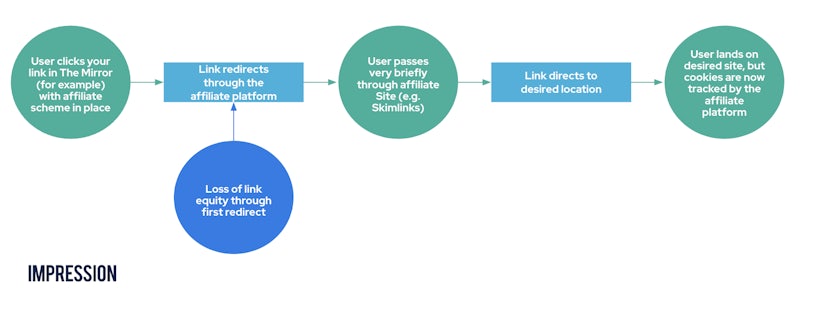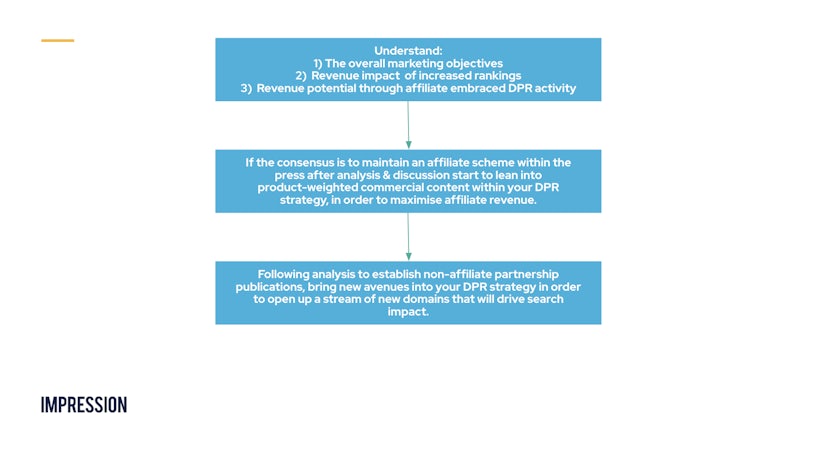“Yes, there’s a link… Oh it’s an affiliate”.
A likely phrase uttered by Digital PR teams as the redirect chain flags when investigating the linked page.
But why is an affiliate link within coverage a point of frustration? Essentially an affiliate redirect on a link means there’s a redirect chain in place, the link often redirects through an affiliate platform before reaching the desired site.
The redirect allows the affiliate platform to track the user through cookies, monitoring whether they end up going on to make a purchase and consequently dealing a commission to the publisher:

The issue from an organic marketing perspective lies in the goal of that link in the first place. It’s very likely that the purpose of building the link in question is to support a wider SEO strategy to increase search visibility. With a redirect chain now in place (through an affiliate scheme), the impact of that link is immediately diluted as it needs to pass through one site before it reaches its destination, losing link equity on its journey.
What becomes a problem here for many teams is the conflicting investments within a marketing budget. Digital PR is often employed as part of a wider SEO strategy to help drive search impact and fulfil the much-needed authority pillar of SEO. Affiliate marketing is employed to open up more immediate revenue-driving streams, but can often – dependent on the publisher – work against the objectives of the SEO & DPR strategy, due to the redirects.
Another issue within Digital PR, press and affiliates is the maturity and use of affiliate schemes. In my opinion, this is where the frustration around affiliate links should be directed, rather than toward the affiliate scheme specifically.
Skimlinks, arguably the most prolific affiliate platform that Digital PRs come into contact with advises the use of ‘commerce content’ which it splits into two categories. ’Timely’ & ‘Timeless’ content:
Timely Content
Is a trending opportunity. It can be focused around a product launch or linked to a limited-time discount, or a specific event like The World Cup. In an ideal world, it drives a high amount of conversions over a short period and is essentially disposable.
Timeless Content
Can also be called “evergreen content”. These should be built around recurring events like Black Friday or Mother’s Day or items like jeans that never go out of style. They may not have the same high initial drive of conversions, but over the course of time should prove consistently valuable. Their lifetime value can also be extended by adding new links from time to time. It keeps the posts relevant in search engines and ensures people can always make a purchase when they land on your post.
The concept of this works in principle, but in practice, affiliate redirects aren’t limited to these two types of content. Instead, we see affiliate links from participating publishers present in all links, no matter the type of content. Essentially meaning an expert comment, around say ‘sleeping in the heat’ when linked, will pass through an affiliate redirect. In this example, the content isn’t commerce-related, the destination link isn’t a product page and the reader has no intention to purchase. There’s seemingly a blanket affiliate rule applied to all links rather than strategic use by publishers, presumably in a bid to drive as much revenue via commission as possible.
But, with the context and the bugbears in mind, there are ways to embrace an affiliate scheme so that the marketing budget and the services employed can work efficiently.
Before that though, an understanding of the scheme, its impacts, and implications on other channels should be understood by all stakeholders, as well as immediate and high-priority objectives. This mutual understanding will make crafting a strategy that appeases all services much easier.
Embracing the scheme through product-centric, commercial content
The businesses opting to use an affiliate scheme are likely consumer e-commerce brands targeting a mainstream consumer audience. Affiliate schemes here can be lucrative (putting aside the bugbears mentioned previously) and will likely feature as part of the general consumer press (nationals, locals & lifestyle). This is where the brand’s customer is and so in theory it makes sense. For Digital PR, it means links in this press will largely be plagued by affiliate redirects (bugbears in mind).
But, a Digital PR strategy here could be crafted to embrace affiliates, a win-win for the business (capturing revenue and customers with intent) and for the publications (a higher chance of achieving commission). The strategy in this area could weigh towards embracing products, product benefits, deals and offers, all while still maintaining expertise alongside.
Alongside this, broadening the reach of your content to target domains not part of the affiliate schemes
There are LOTS of links that can be achieved outside of affiliate-partnered press. Research here is important to establish which publishers are not within the schemes. The DPR strategy here likely calls for a campaign-led approach where your output is immediately opened up to new avenues publication/domain-wise through various angles. Through these means, our strategy can also earn links that will better impact search from non-affiliate impacted domains.
For some brands though, there is potentially a challenge here in terms of longevity of activity in wider domains outside of core consumer press. Ultimately this could mean coverage in publications that won’t resonate with their customer, something that would need managing from a wider brand & PR perspective with all objectives e.g. search, taken into account.
It’s important to understand where revenue comes from through affiliate partnerships
It’s important to understand the success and impact these schemes are having. For example, affiliate partnerships through voucher websites are highly lucrative and drive good levels of revenue.
But, with the catch-all approach to affiliate linking by news publications and with a PR strategy not weighted towards product-centric coverage, there may not be much revenue driven here. In which case, opting out of that element of the scheme that impacts publishers would be fruitful given your site would benefit more so from a search perspective.
However, I would recommend a test-and-learn approach here in terms of what revenue levels can be driven through news publishers with a product-centric approach to DPR. It’s also worth understanding from an SEO forecast, what impact revenue-wise, increased rankings can have and if this is enough to eclipse any affiliate-generated revenue from publishers – something which would also need forecasting based on data from your test. The process for managing affiliate partnerships on a site could look like the below:

Affiliate schemes shouldn’t be the enemy of Digital PR teams and as with any other marketing channel, we should be finding ways to embrace and work alongside to ultimately drive business growth.
If you’re struggling with integrating your Digital PR activity into a marketing strategy that includes affiliate marketing, then get in touch!



